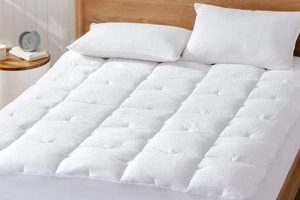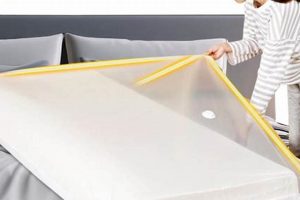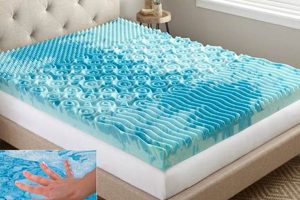A cushioning layer designed to enhance the sleep surface, often constructed from materials like memory foam or down alternatives, aims to provide additional comfort and pressure relief. Placed atop an existing bed, it modifies the feel, offering a softer, more plush experience.
The utilization of such bedding accessories can significantly improve sleep quality by alleviating pressure points and distributing weight more evenly. This can be particularly beneficial for individuals experiencing discomfort from a firm bed or seeking to extend the lifespan of their current mattress. Historically, similar solutions have existed in various forms, evolving from simple padding to technologically advanced materials designed for optimal comfort and support.
Subsequent sections will delve into the diverse types available, factors to consider when selecting a suitable option, and best practices for maintaining the chosen product to ensure longevity and continued comfort. These aspects will provide a comprehensive understanding for informed decision-making.
Enhancing Sleep Quality
Implementing specific strategies can maximize the potential benefits derived from a supplementary sleep surface layer. Careful attention to detail ensures optimal performance and longevity.
Tip 1: Assess Existing Mattress Condition: Before acquisition, evaluate the existing mattress for sagging or structural deficiencies. A new layer will only partially mitigate underlying support issues.
Tip 2: Prioritize Material Compatibility: Consider the materials used in the existing mattress and select a compatible topper. For example, a latex mattress might benefit from a latex layer to enhance responsiveness, while memory foam can add contouring to a firmer surface.
Tip 3: Consider Thickness and Density: The thickness and density of the chosen product directly impact its firmness and support. Thicker, denser materials generally offer more substantial cushioning and pressure relief.
Tip 4: Evaluate Temperature Regulation Properties: Certain materials, such as gel-infused memory foam or open-cell foam, are designed to improve airflow and reduce heat retention. Individuals prone to overheating should prioritize these options.
Tip 5: Use Appropriate Bedding: Employ breathable sheets and bedding to maximize the benefits of temperature-regulating layers. Heavy, non-breathable materials can negate the cooling effects.
Tip 6: Rotate Regularly: Periodically rotate the added layer to promote even wear and prevent the formation of body impressions. This practice extends its lifespan and maintains consistent comfort.
Tip 7: Employ a Mattress Protector: Utilizing a mattress protector safeguards the layer from spills, stains, and allergens, thereby preserving its integrity and hygiene.
Adhering to these guidelines can significantly enhance the comfort and lifespan of an added sleep surface layer, leading to improved sleep quality and overall well-being.
The following sections will address specific material types and their suitability for various sleep preferences and needs.
1. Thickness Variations
The thickness of a supplementary sleep surface layer directly influences its impact on the feel and support provided. Varying thicknesses cater to different needs and preferences, altering the sleep experience in significant ways. Understanding these variations is crucial for selecting the optimal layer.
- Impact on Firmness and Softness
Thicker layers generally provide more cushioning and a softer feel. Conversely, thinner layers offer minimal alteration to the original mattress firmness. For example, a 2-inch memory foam supplementary layer might soften a moderately firm mattress, while a 4-inch layer could transform it to a plush surface. The choice depends on the degree of desired change.
- Influence on Pressure Relief
Increased thickness enhances pressure relief by distributing weight more evenly across a larger surface area. This is particularly beneficial for individuals experiencing joint pain or pressure sores. A thicker option allows for greater contouring and accommodation of body weight, reducing concentrated pressure points.
- Effect on Support and Spinal Alignment
While adding thickness generally softens the sleep surface, it can also negatively impact support if the existing mattress lacks adequate foundation. A very thick, soft supplementary layer on a sagging mattress may exacerbate spinal misalignment. Therefore, thickness must be balanced with the underlying support system.
- Impact on Heat Retention
Thicker layers, especially those made from dense materials like memory foam, can trap more heat. Individuals prone to overheating should consider materials with enhanced breathability or opt for thinner options to mitigate heat retention. This consideration is crucial for maintaining a comfortable sleep temperature.
The selection of a specific thickness is intrinsically tied to the individual’s sleep preferences, existing mattress characteristics, and any specific needs related to pressure relief or temperature regulation. A careful evaluation of these factors ensures the chosen product effectively complements the existing sleep setup and provides the desired comfort and support.
2. Material Density
Material density, a crucial attribute of any supplementary sleep surface layer, dictates its support, durability, and overall performance. Density refers to the mass of the material per unit volume, typically measured in pounds per cubic foot (PCF). A higher density generally indicates a more robust and resilient structure, directly impacting the lifespan and comfort it provides. For instance, a low-density memory foam option may initially offer a plush feel, but it will likely compress and degrade more rapidly than a higher-density counterpart, losing its supportive properties over time. This difference in density can translate to uneven weight distribution, leading to pressure points and diminished sleep quality.
Consider two products constructed from memory foam. One has a density of 3 PCF, while the other boasts a density of 5 PCF. The 3 PCF option will likely be less expensive but will exhibit greater compression under sustained pressure, resulting in sagging and reduced support. Conversely, the 5 PCF choice, while potentially costing more upfront, will maintain its shape and support for a longer duration, offering a more consistent and comfortable sleep surface. This distinction is particularly significant for individuals seeking long-term solutions or those requiring specific levels of support due to physical conditions.
Understanding the significance of material density allows for informed purchasing decisions. While initial comfort is essential, the long-term p
erformance and value are intrinsically linked to this often-overlooked attribute. Selecting a product with appropriate density ensures sustained support, extended lifespan, and ultimately, a more restful sleep experience. Disregarding density in favor of lower prices often leads to premature replacement and a diminished return on investment.
3. Support Structure
The underlying architecture of a supplementary sleep surface layer significantly influences its capacity to provide proper spinal alignment and pressure relief. The support structure dictates how the layer interacts with the existing mattress and how it distributes weight. A robust support structure is essential for maximizing the benefits and preventing premature wear and tear.
- Core Material Composition
The core material determines the foundational support. High-density foam, latex, or innerspring constructions within the layer provide varying degrees of firmness and resistance to compression. For example, a memory foam supplementary layer with a high-density polyfoam base offers better long-term support than one with a low-density base. This core bears the brunt of the body’s weight and prevents sagging.
- Zoning and Targeted Support
Some advanced designs incorporate zoning, where different sections of the layer offer varying levels of support. This is often achieved through varying foam densities or strategically placed support elements. A layer designed with firmer support in the lumbar region can promote proper spinal alignment and reduce back pain, a critical factor for many users.
- Edge Support Reinforcement
Edge support refers to the stability and firmness along the perimeter of the supplementary layer. Reinforced edges prevent the “roll-off” sensation and provide a more usable sleep surface. Without adequate edge support, the edges of the layer may compress under pressure, reducing the overall sleeping area and making it less comfortable to sit on the edge of the bed.
- Integration with Existing Mattress
The support structure must complement the existing mattress. A very soft, thick supplementary layer on a sagging mattress may exacerbate support issues. Conversely, a firmer layer on a very soft mattress may improve support. Understanding the existing mattress characteristics is essential for selecting a compatible supplementary layer that enhances, rather than detracts from, the overall support system.
The relationship between the supplementary layer’s support structure and the existing mattress is paramount. The choice of material, zoning, and edge support should be carefully considered to ensure optimal spinal alignment, pressure relief, and long-term durability. A well-designed and appropriately chosen support structure maximizes the potential benefits, resulting in a more comfortable and restorative sleep experience.
4. Pressure Relief
Pressure relief, a critical function of supplementary sleep surface layers, directly mitigates concentrated force on specific areas of the body during sleep. Absence of adequate pressure relief leads to discomfort, restricted blood flow, and potential musculoskeletal issues. The design and material composition directly influence the effectiveness of pressure distribution. For example, individuals experiencing hip or shoulder pain often find that layers constructed from viscoelastic memory foam or highly resilient latex conform to the body’s contours, reducing pressure on these sensitive joints. Without such adaptive characteristics, the body’s weight is concentrated on bony prominences, interrupting sleep cycles and contributing to chronic discomfort.
Practical application of pressure-relieving materials extends beyond mere comfort. Individuals with conditions such as fibromyalgia or arthritis benefit significantly from the reduction in pressure points, leading to improved sleep quality and reduced pain levels. The selection of a layer with appropriate pressure-relieving properties can be viewed as a preventative measure against the development or exacerbation of pressure sores, particularly relevant for individuals with limited mobility or those confined to bed for extended periods. Material properties such as density, indentation force deflection (IFD), and the presence of gel infusions affect the degree of pressure relief provided, warranting careful consideration based on individual needs. For instance, a higher IFD rating indicates a firmer material that may not be suitable for individuals seeking maximum pressure reduction.
In summary, effective pressure relief is a fundamental attribute of a quality supplementary sleep surface layer. Its impact extends from basic comfort to the management of chronic pain and the prevention of pressure-related health issues. The careful selection of materials and design features is essential to maximize its benefits. Disregarding this aspect risks compromised sleep quality and potential adverse health consequences. Further research into advanced materials and design techniques continues to refine pressure-relieving capabilities, promising even greater comfort and therapeutic benefits in the future.
5. Heat Dissipation
Heat dissipation is a crucial consideration for any supplementary sleep surface layer, directly affecting sleep comfort and quality. The ability to regulate temperature and prevent heat buildup is particularly relevant given the proximity of the layer to the sleeper’s body. The following points explore critical facets of heat dissipation within the context of these products.
- Material Thermal Conductivity
Thermal conductivity refers to a material’s ability to transfer heat. Materials with high thermal conductivity, such as open-cell foam or gel-infused memory foam, dissipate heat more effectively than those with low conductivity, such as dense, closed-cell memory foam. The selection of materials with superior thermal conductivity is essential for maintaining a comfortable sleep temperature, especially for individuals prone to overheating. The practical implication is that a layer composed of breathable materials will feel cooler throughout the night.
- Airflow and Ventilation Design
The design of the supplementary sleep surface layer significantly influences airflow. Layers with convoluted surfaces, perforations, or open-cell structures promote air circulation, facilitating heat dissipation. Without adequate ventilation, heat becomes trapped between the body and the layer, leading to discomfort and interrupted sleep. For instance, a layer with a channeled surface allows air to circulate freely, wicking away moisture and promoting evaporative cooling.
- Moisture-Wicking Properties
Moisture accumulation exacerbates heat retention. Materials with moisture-wicking properties draw perspiration away from the body, promoting evaporative cooling. This is particularly important in humid environments or for individuals who perspire heavily during sleep. Examples include fabrics like Tencel or specialized performance knits used in the layer’s cover.
- Influence of Bedding and Environmentrong>
The surrounding bedding and environmental factors affect the layer’s ability to dissipate heat. Using breathable sheets and maintaining a cool room temperature optimize heat regulation. Heavy, non-breathable bedding can negate the effects of a cooling layer, trapping heat and increasing discomfort. A controlled sleep environment significantly enhances the effectiveness of heat dissipation.
The interplay between material properties, design features, and environmental factors determines the overall effectiveness of heat dissipation in supplementary sleep surface layers. Careful consideration of these aspects is essential for selecting a product that promotes a cool, comfortable, and restorative sleep experience. Understanding these elements allows consumers to make informed choices aligned with their individual temperature preferences and sleep needs.
6. Durability Over Time
The longevity of a supplementary sleep surface layer directly correlates with its constituent materials and construction techniques. The effects of continuous use and compression exert significant stress, leading to potential degradation. For instance, a layer constructed from low-density memory foam will exhibit diminished support and increased compression over a relatively short period compared to a high-density latex alternative. This degradation influences the degree of pressure relief, spinal alignment, and overall sleep quality provided. Therefore, the initial purchase price should be weighed against the expected lifespan and potential for performance decline. A seemingly cost-effective option may prove more expensive in the long term if it requires frequent replacement.
Real-world examples demonstrate the practical implications of durability. Consider two individuals who purchase supplementary sleep surface layers. The first selects a product with a high-density core and reinforced edges. After several years, the layer maintains its shape, support, and original level of comfort. The second individual opts for a less expensive, lower-density option. Within a year, the layer begins to sag in the center, leading to discomfort and necessitating replacement. This scenario underscores the importance of considering the long-term performance characteristics during the purchasing decision. Practical significance lies in the understanding that investing in durable materials and robust construction techniques yields a greater return on investment over the lifespan of the product.
In summary, durability is a paramount attribute directly influencing the value proposition of a supplementary sleep surface layer. The interplay between material quality, construction, and long-term performance dictates the sustained comfort and support provided. Challenges arise in accurately assessing durability at the point of purchase, necessitating careful evaluation of material specifications and manufacturer reputation. Ultimately, prioritizing durability ensures continued sleep quality and minimizes the long-term financial burden associated with premature replacement.
Frequently Asked Questions About Supplementary Sleep Surface Layers
The following questions address common inquiries and misconceptions regarding supplementary sleep surface layers, providing clarity for informed decision-making.
Question 1: What is the typical lifespan?
Lifespan varies based on materials and usage. High-density latex or memory foam options may last 5-8 years, while lower-density materials may require replacement within 2-3 years. Proper maintenance influences longevity.
Question 2: Can it correct a sagging mattress?
It offers limited support improvement. A severely sagging mattress requires replacement, as the layer primarily enhances comfort, not structural integrity.
Question 3: How does it affect temperature regulation?
The impact depends on materials. Memory foam retains heat, while latex and open-cell foams promote breathability. Cooling gel infusions are designed to mitigate heat retention.
Question 4: What is the ideal thickness?
Thickness depends on desired comfort level and existing mattress firmness. A 2-3 inch layer provides moderate cushioning, while a 4-inch or thicker layer offers more substantial softness.
Question 5: Are there hypoallergenic options?
Latex and certain synthetic materials are naturally hypoallergenic. Protective covers further reduce allergen accumulation. Regular cleaning is recommended.
Question 6: How is it cleaned?
Spot cleaning is generally recommended. Removable covers can be machine-washed. Avoid harsh chemicals. Professional cleaning is advisable for deep stains.
In summary, careful consideration of material properties, thickness, and maintenance practices is essential for maximizing the benefits and extending the lifespan of supplementary sleep surface layers.
Subsequent sections will explore specific material options and their suitability for various sleep preferences and needs.
Conclusion
The preceding exploration of “cloud topper mattress” has illuminated critical aspects, encompassing material properties, support structures, heat dissipation, and long-term durability. These features directly influence the product’s ability to enhance sleep quality and overall well-being. Careful consideration of these factors, aligned with individual needs and existing mattress characteristics, is essential for informed purchasing decisions.
The selection of a supplementary sleep surface layer represents a commitment to optimizing sleep comfort and promoting physical health. By prioritizing material quality, construction, and proper maintenance, individuals can maximize the potential benefits. Further research and technological advancements promise continued improvements in design and material science, potentially leading to even more effective and personalized sleep solutions in the future.


![Best Mattress Firm Mattress Topper: [Guide] Your Sleep Upgrade! Organic & Natural Mattress Buyer’s Guide: Non-Toxic Sleep Solutions Best Mattress Firm Mattress Topper: [Guide] Your Sleep Upgrade! | Organic & Natural Mattress Buyer’s Guide: Non-Toxic Sleep Solutions](https://mattressworldpa.com/wp-content/uploads/2025/07/th-5922-300x200.jpg)




